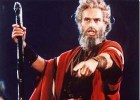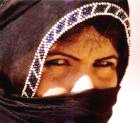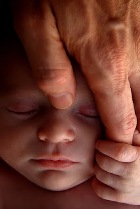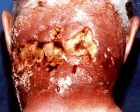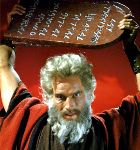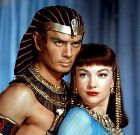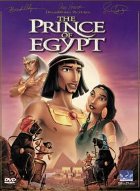Paintings of Moses
- What’s the point of Moses’ story? To show that nothing can destroy the people of Israel, or thwart God’s purpose. Nothing.
- Why were the royal women bathing in the Nile? Because it was regarded as a
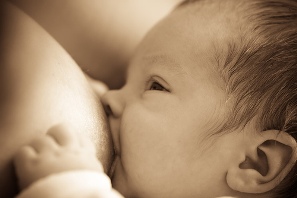 sacred river, and bathing in it was a semi-religious practice.
sacred river, and bathing in it was a semi-religious practice. - Who was the daughter of Pharaoh? Josephus calls her Thermutis, but Eusebius calls her Merris. Pharaoh had a large harem and many daughters, and we don’t know how high-ranking she was.
- What happened to the baby Moses? His mother kept him until he was about two or three years old and fully weaned. Then he was adopted by Pharaoh’s daughter and received the education of an Egyptian prince.
Moses found in the bulrushes
‘The Finding of Moses’, Orazio Gentileschi
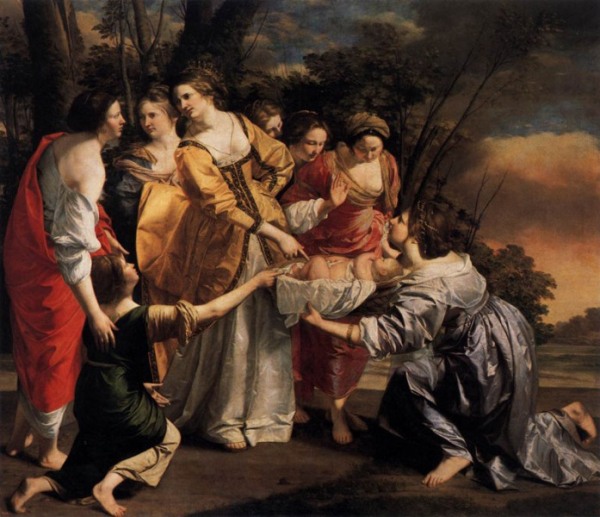
Bible reference: Exodus 2:1-10
What a graceful painting. See how the pointing hands of the women draw our attention to chubby little Moses. The women are more beautiful, more powerful – but he is the center of the story.
Caravaggio had burst upon the art world by the time Gentileschi painted this picture, and most painters were trying to emulate his realism. Not Gentileschi. He managed to avoid the stark contrasts and frightening energy of Caravaggio’s paintings. He stood for harmony and beauty.
‘Moses rescued from the River Nile’, Charles della Fosse
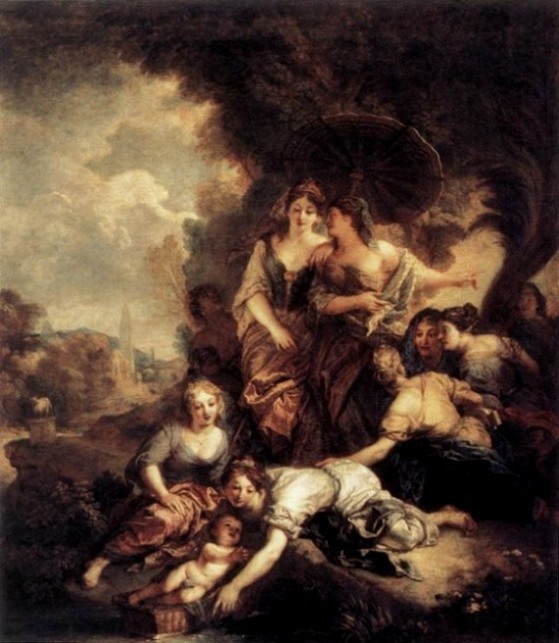
See how the placement of the figures draws our eyes to the bottom of the painting, and the tiny baby there. Moses is the focus.
And notice the exotic Egyptian obelisk in the background. There were obelisks everywhere in Rome at the time, with mysterious, as-yet-undeciphered hieroglyphics – della Fosse must have been familiar with them.
‘The Baby Moses Saved From The River’, Nicolas Poussin
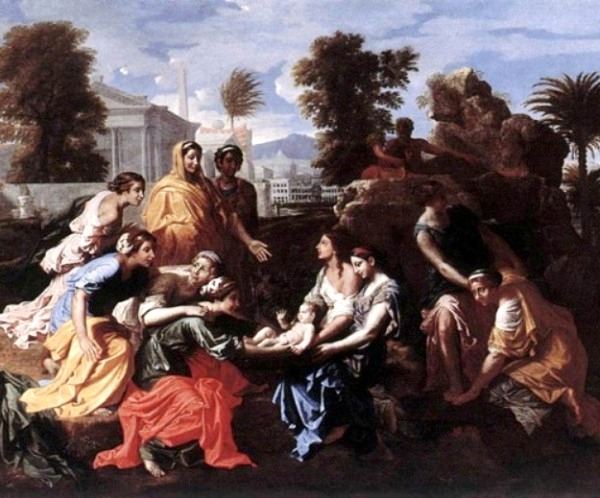
Bible reference: Exodus 2:1-10
Again, baby Moses is the focus of attention, but this time he shares it with the regal, gold-clad princess who stands high among the delighted women. The building behind her is Greek or Roman rather than Egyptian, but never mind.
‘Moses found’, Paolo Veronese
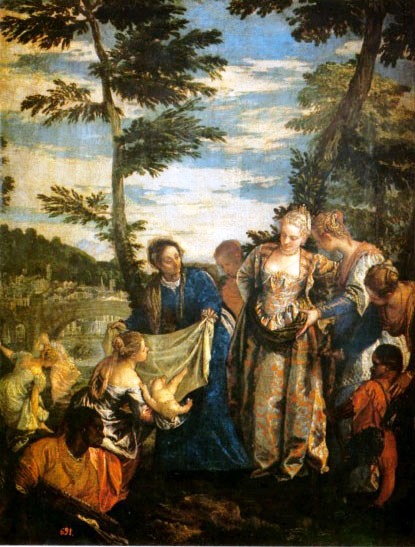
The princess of Egypt in a crinoline? But what sumptuous fabric, what a beautiful blond woman against the backdrop of a pale blue sky.
Brilliant colours, confident brushwork, important subjects – these paintings were meant to decorate palaces, competing for attention with the royals who owned them.
Footnote: one worries about the baby Moses – is he about to be dropped on his little head? Perhaps Veronese did not have much to do with real babies…
‘The Finding of Moses’, Frederick Goodall
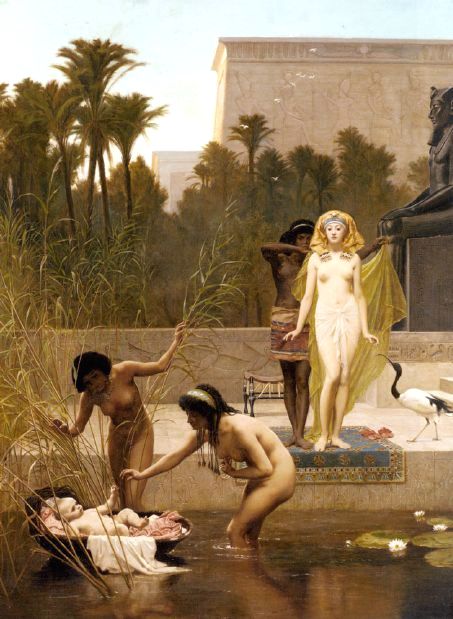
Bible reference: Exodus 2:1-10
Now, Mr. Goodall, your cover is blown. This may ostensibly be a painting of the finding of Moses, but really it seems more like an excuse to show beautiful nudes. Baby Moses is there of course, as are two authentic Egyptian pylons behind the figures. But the focus is not, I fear, on biblical matters, or on ancient architecture…
‘The Finding of Moses’, Lawrence Alma-Tadema
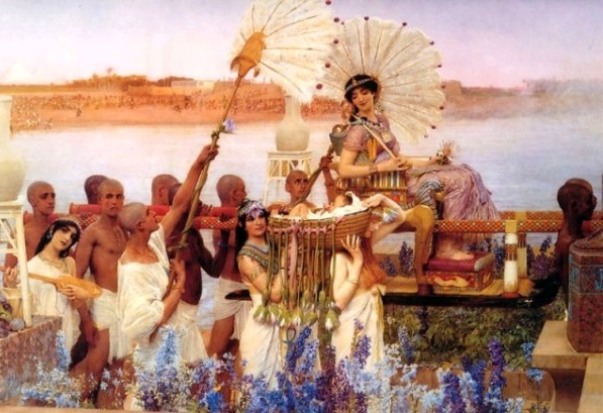
A joyous, triumphal procession. The princess of Egypt looks fondly down on her new son: what sort of man will he be? Already she has the proprietorial gaze of a proud mother…
Though I doubt there were hyacinths in ancient Egypt… but never mind. They add to the festive air of this world-changing moment.
Bible reference: Exodus 2:1-10
‘The Finding of Moses’, Edwin Long
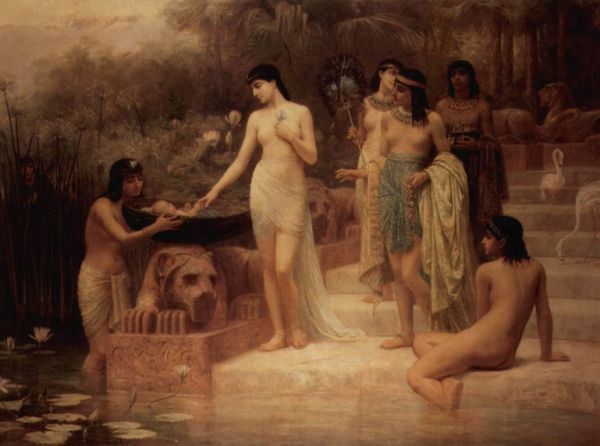
Bible reference: Exodus 2:1-10
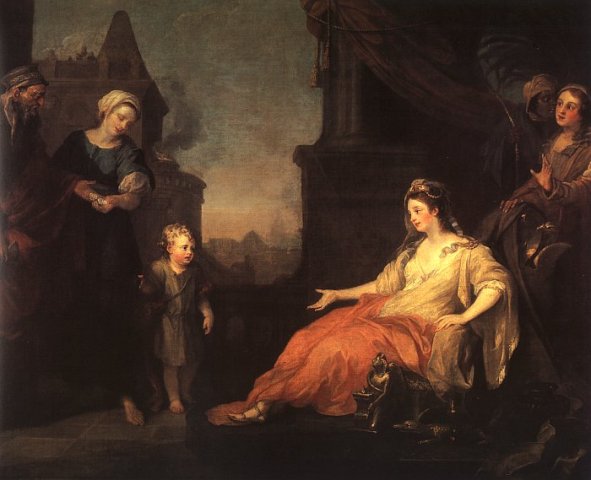
Moses brought before Pharaoh’s daughter, William Hogarth, 1746
Moses and the Burning Bush
- Why is there a ‘burning bush’? What does it mean? Fire is a common symbol of God in the Bible. It brings light, it purifies what it touches, but it can also destroy.
- Why does Moses take off his shoes? To take off the shoes is an ancient way of expressing reverence in the Middle East. An Islamic man takes off his shoes when he enters the mosque – it is a way of shedding the defilement of the outside world.
- What does God’s name mean? Jahve or Yahve is connected with the verb hawa or haya, ‘to be’. God calls himself simply I AM.
‘Moses sees God in the Burning Bush’, illuminated manuscript
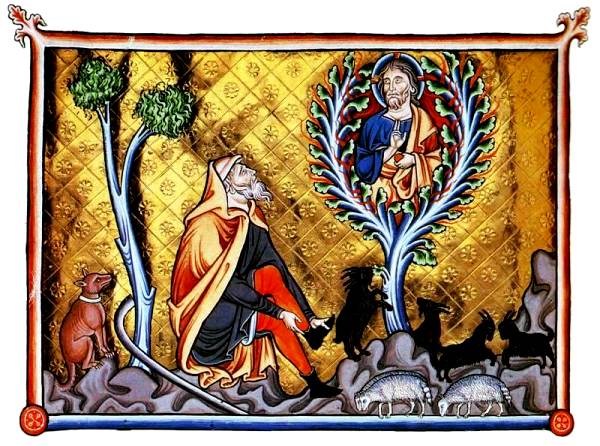
Bible reference: Exodus 3:1-15
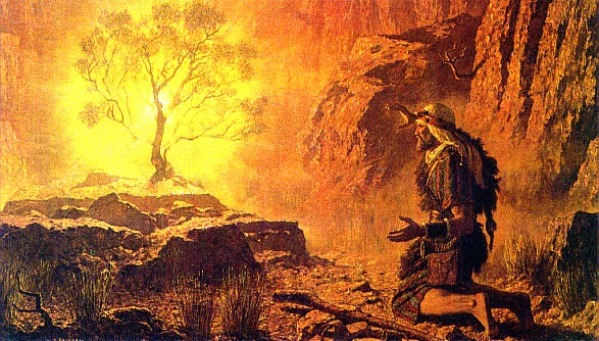
Bible reference: Exodus 3:1-15
The Ten Plagues of Egypt
- Who were the magicians in ancient Egypt? Everyone in ancient Egypt believed in magic. Magicians were often employed to interpret dreams, to avert bad luck, and to bring misfortune on someone you hated. Snake charming is still practised in Egypt.
- Did the water of the Nile turn to blood? Actually it always turned a dull red color in the annual flood – with mud, vegetable matter, and debris. But this time it was different, because all the fish died as well, which did not happen in the annual flood. A catastrophe.
- A plague of frogs was particularly repulsive, since frogs were sacred, representing reproduction in Nature. One ancient Egyptian god was represented with a frog’s head.
- There was a plague of lice, fleas or sandflies, then a swarm of flies. Then beetles, particularly frightening in a country that honoured scareb beetles.
- Then a cattle plague, destructive hail, a nation-wide outbreak of boils, a terrible hail-storm, locusts, ‘darkness’ (probably a terrible dust-storm), and then the infamous ‘death of the first-born’.
The River Nile turns to blood
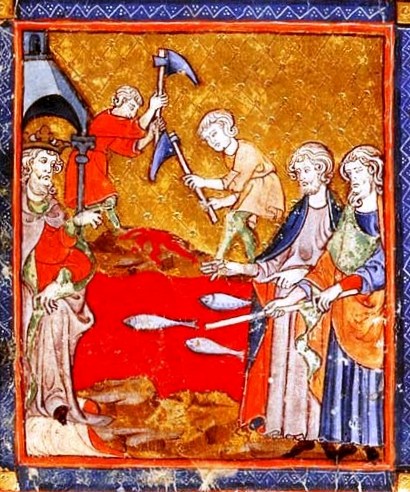
Bible reference: Exodus 12:29-32
Hail destroys the crops and houses of Egypt
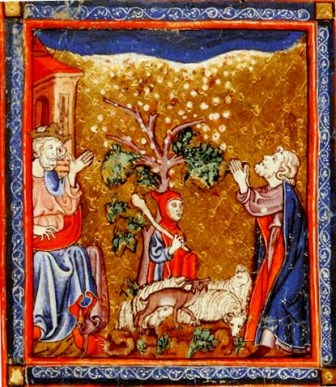
Bible reference: Exodus 12:29-32
‘Death of the Pharoah’s Firstborn’, Sir Lawrence Alma-Tadema, 1872
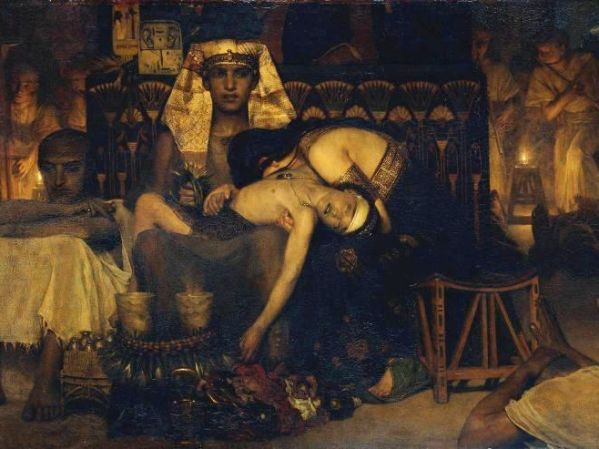
Bible reference: Exodus 12:29-32
Crossing the Red Sea
‘The Crossing of the Red Sea’, Nicolas Poussin, 1633-34
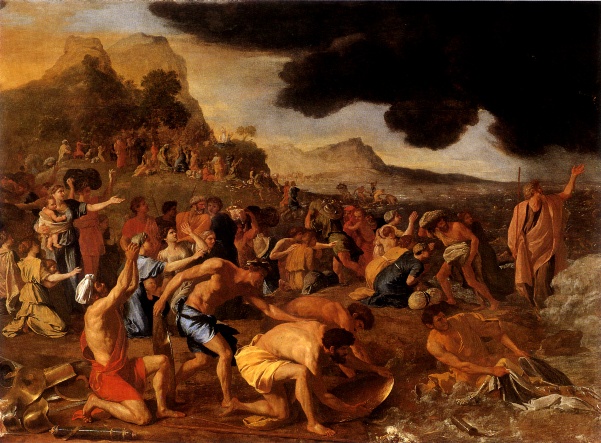
Bible reference: Exodus 14:21-15
Adoration of the Golden Calf
‘Adoration of the Golden Calf’, Nicolas Poussin, 1633
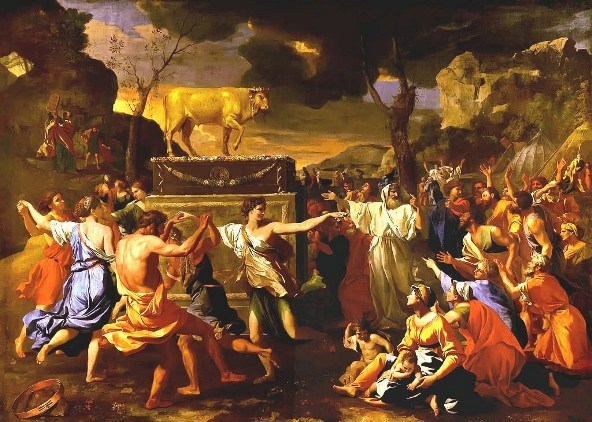
What was the Golden Calf? And what was so offensive about it?
- The calf was really a bullock, a common fertility symbol in the ancient world. But there seems to be some confusion here, because the Egyptians worshipped a living bullock, not an image. It was Assyrians who had images of bullocks – Abraham’s descendants may have copied this. The Assyrians imagined a bull with wings and a human head, symbol of strength and wisdom.
- Moses was focused on the God he had found, but the people were not. They remained loyal to the ancient gods of fertility and agriculture, and were reluctant to abandon them. In the desert they continued to worship a god of plenty who they imaged as a a young calf.
- While Moses was away in the mountains they designed and made a golden image of this god, probably Baal, and worshipped it with orgiastic rituals. When Moses discovered what they had done, he was furious. He smashed the image and forbad them ever to worship in this way again.
Bible reference: Exodus 32
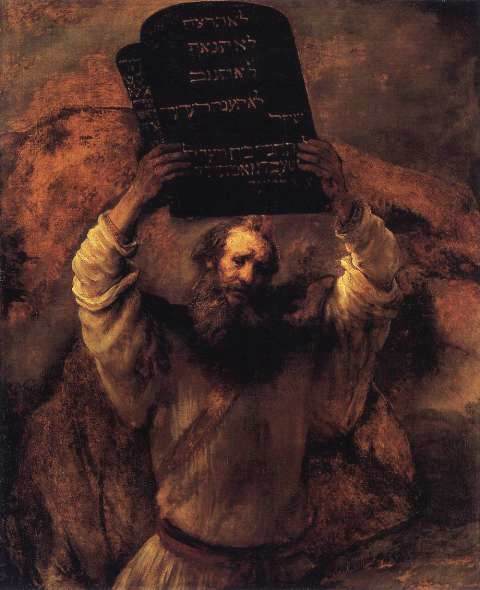
Moses smashing the Tablets of the Law, Rembrandt van Rijn
Moses after receiving the Ten Commandments, Michelangelo
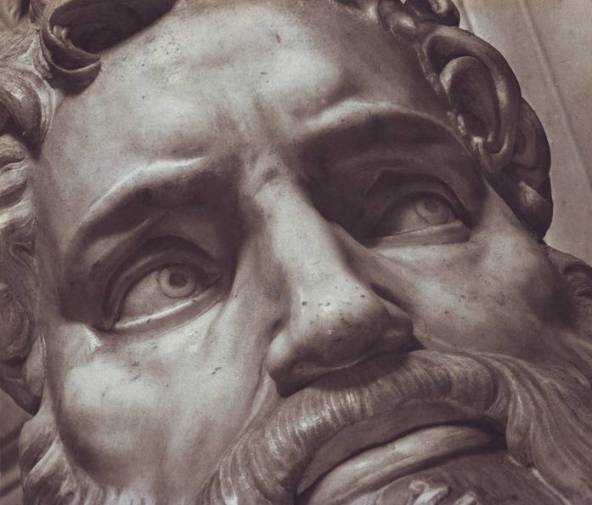
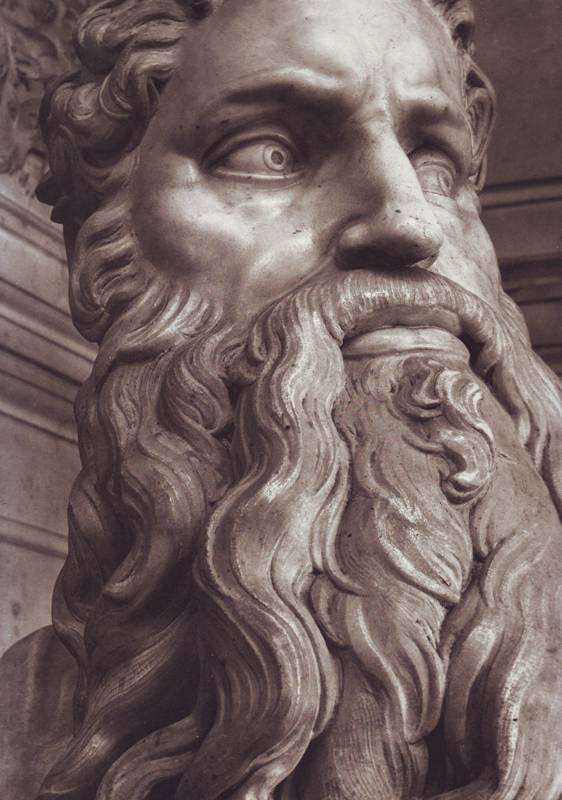
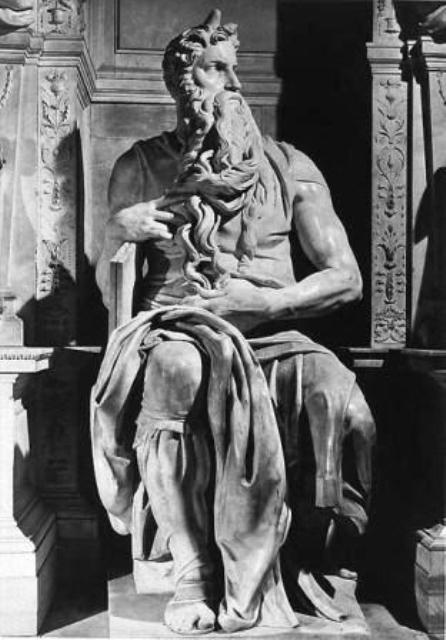
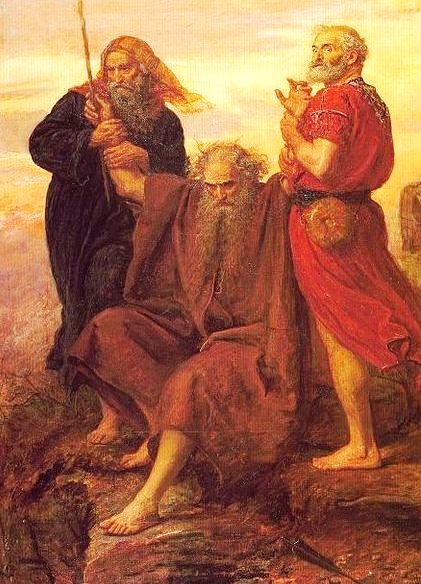
Moses supported by Aaron and Hur, John Everett Millais
The Defeat of the Amalekites
…Exodus 17:11
So it came about when Moses held his hand up, that Israel prevailed, and when he let his hand down, Amalek prevailed. 12But Moses’ hands were heavy. Then they took a stone and put it under him, and he sat on it; and Aaron and Hur supported his hands, one on one side and one on the other. Thus his hands were steady until the sun set. 13So Joshua overwhelmed Amalek and his people with the edge of the sword.…
John Everett Millais was a ‘muscular Christian’: someone who made a great and conscious effort to imbue all aspects of their lives with their strong Christian belief.
Something of this resolute idealism animates “Victory, O Lord’. The painting shows one dramatic moment in the story of Moses. The weary, aged leader promised Joshua that he would stand on a hill with ‘the rod of God’ in his hand, while the battle of Rephidim was fought between the Israelites and the followers of Amalek. Moses watched the battle from the hill, with Aaron and Hur beside him.
Millais’ painting shows Moses, physically exhausted, but filled with trust in God and determined to ensure victory for the Israelite people.
Hidden Meanings
- Passover, which commemorates the escape of Moses and the Hebrew tribes from Egypt, is one of the chief religious festivals of Judaism. Christian artists saw it as a foreshadowing of the Last Supper. The participants are shown standing round a table on which lies the lamb, in a state of readiness for their journey, or loading camels and asses in preparation for their departure.
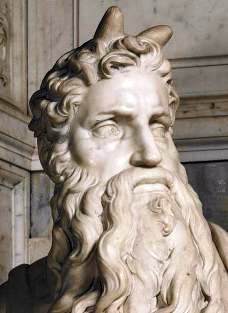
Statue of Moses by Michelangelo
- Rays of light sprout like horns from each side of Moses’ head. This tradition arose because the word cornutam, ‘horned”, was confused with a similar Latin word meaning ‘flashing with rays of light’ or ‘haloed’, which was a description of Moses after he had experienced God face to face.
- While Moses was at Mount Horeb he had a vision of a bush that burned but was not consumed. God spoke from the bush, telling him he was destined to deliver the Israelites out of the hands of their oppressors, the Egyptians, and to lead them into Canaan, ‘a land of milk and honey’. Moses is shown kneeling before the bush, or removing his shoes as Muslims do on holy ground. To the medieval Christian Church the bush, burning but unconsumed, symbolized the Virgin Mary who bore Christ yet kept her virginity intact.
- Christian artists saw Moses as a prefiguration of Christ, and many parallels were drawn between their lives.
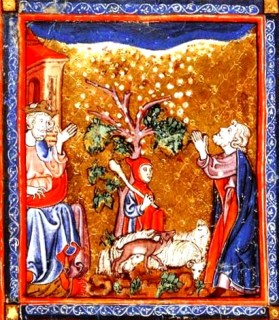
Hail, one of the Ten Plagues of Egypt, medieval painting
The frescoes in the Sistine chapel showing the life-cycles of Moses and Christ on opposite walls were meant to be interpreted in this sense.
- The Ten Plagues that Moses imposed on Egypt were reminders that God ruled Nature, and not the reverse – see the plague of hail that destroyed the Egyptian crops (right).
- The finding of Moses was seen as a prefiguration of the ‘Flight into Egypt’, when Joseph, Mary and Jesus fled from Herod’s massacre of the innocents. Stories of heroes who are exposed in infancy and rescued by the hand of Fate occur elsewhere in near-eastern and Greek myth. There is a similar account of the birth of the Babylonian king, Sargon I, telling how his mother put him in the river in an ark of bulrushes daubed with pitch.
The story of Moses
Baby Moses cast adrift in the Nile
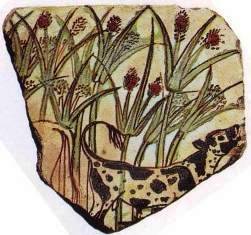
Faience fragment with bulrushes, circa 1350BC. Papyrus bulrushes were used in many ways, as the story of Moses shows
Moses was born at a bad time. The Jewish population in Egypt was growing too rapidly, and Pharaoh ordered that all male Jewish babies be killed at birth – this would control their population.
Moses’ mother hid her baby, putting him in a papyrus basket and pushing the little Ark on the Nile river. God would decide his fate.
The baby’s sister Miriam followed, watching. The basket drifted towards a bathing party – one of the Pharaoh’s daughters was there with her slaves. When they looked in the basket they found a live, apparently abandoned baby.
The little baby was adopted by the royal women, and Moses was brought up in the court.
Moses Leaves the Safety of the Palace
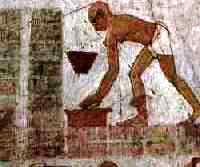
Brick-making in ancient Egypt
One day Moses sided with a Hebrew being beaten by an Egyptian, and he killed the Egyptian. To avoid imprisonment he headed out into the desert, where he lived as a shepherd. He married and became a father, his father-in-law being the priest Jethro.
At about this time there was a mass movement of the Jewish people out of Egypt. According to the Bible story, Moses led this movement.
In a vision, Moses saw God in the form of a burning bush. God commanded Moses to ‘bring my people out of Egypt’. When Moses pointed out that this might not be easy, given the relative social standing of himself and the Pharaoh, God revealed his identity – ‘I Am Who I Am’ and gave instructions on how Moses should proceed. He also gave Moses the power to perform miracles. Thus fortified, Moses confronted Pharaoh.
The Ten Plagues
Not surprisingly, Pharaoh did not agree to Moses’ demand, so in a final confrontation Moses imposed ten plagues on the Egyptians:
- water which turned to blood;
- swarming frogs;
- gnats and biting insects;
- disease-carrying flies;
- diseased cattle and livestock;
- eruptions of boils on the skin of people;
- hailstorms that destroyed crops;
- locusts that ate any crop that had survived;
- unexplained darkness over the land;
- and the last and most terrible, the death of every firstborn member of a generation, a repetition of the killing of the Hebrew babies of Moses’ generation
(go to Bible Plagues for some ghastly images of the Ten Plagues.) 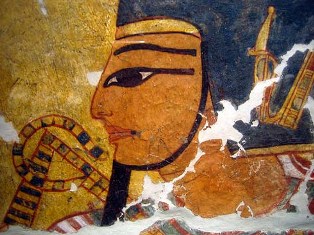
During the last plague, the death of every firstborn, the first Passover was celebrated by the Hebrews. Under the barrage of misfortune and plague, Pharaoh conceded defeat and agreed to let the Hebrews go. They left Egypt, following a pillar of cloud – God in earthly form. The pillar appeared as a cloud by day and a pillar of fire by night. They were led by Moses and his brother and sister, Aaron and Miriam.
The Parting of the Red Sea
But Pharaoh regained his composure and pursued them, triggering another disaster – the drowning of his army in the Red (Reed) Sea.
Then began the long wandering in the desert, where the Hebrews became what they had once been – nomadic herdsmen.
The Ten Commandments
Eventually they came to Mount Sinai, where Moses received the Ten Commandments, (see How To Get To Heaven for a modern reworking of the Ten Commandments). This complex system of laws would serve the Hebrews throughout their history.
The Golden Calf – A False God
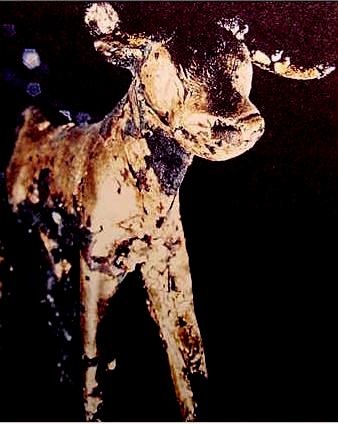
Phoenician image of the god Baal as a young calf; it was originally covered with gold leaf
Moses was focused on the God he had found, but the people were not. They remained loyal to the ancient gods of fertility and agriculture, and were reluctant to abandon them. In the desert they continued to worship a god of plenty who they imaged as a a young calf.
While Moses was away in the mountains they designed and made a golden image of this god, probably Baal, and worshipped it with orgiastic rituals.
When Moses discovered what they had done, he was furious. He smashed the image and forbad them ever to worship in this way again.
Mission Accomplished
The group of Hebrews moved northwards into Canaan. This is where the Hebrews, now the first Israelites, would put down roots.
Moses was not to see this happen. He died on the borders of the new land, in Moab – but his work and faith produced a people who remembered not only slavery in Egypt, but freedom under God.
The Bible text
Moses Saved From the Nile – Exodus 2:1-10
1 Now a man from the house of Levi went and took to wife a daughter of Levi.
2 The woman conceived and bore a son; and when she saw that he was a goodly child, she hid him three months.
3 And when she could hide him no longer she took for him a basket made of bulrushes, and daubed it with bitumen and pitch; and she put the child in it and placed it among the reeds at the river’s brink.
4 And his sister stood at a distance, to know what would be done to him.
5 Now the daughter of Pharaoh came down to bathe at the river, and her maidens walked beside the river; she saw the basket among the reeds and sent her maid to fetch it.
6 When she opened it she saw the child; and lo, the babe was crying. She took pity on him and said, “This is one of the Hebrews’ children.”
7 Then his sister said to Pharaoh’s daughter, “Shall I go and call you a nurse from the Hebrew women to nurse the child for you?”
8 And Pharaoh’s daughter said to her, “Go.” So the girl went and called the child’s mother.
9 And Pharaoh’s daughter said to her, “Take this child away, and nurse him for me, and I will give you your wages.” So the woman took the child and nursed him.
10 And the child grew, and she brought him to Pharaoh’s daughter, and he became her son; and she named him Moses, for she said, “Because I drew him out of the water.”
The Burning Bush – Exodus 3:1-15
1 Now Moses was keeping the flock of his father-in-law, Jethro, the priest of Mid’ian; and he led his flock to the west side of the wilderness, and came to Horeb, the mountain of God.

File written by Adobe Photoshop? 4.0
2 And the angel of the Lord appeared to him in a flame of fire out of the midst of a bush; and he looked, and lo, the bush was burning, yet it was not consumed.
3 And Moses said, “I will turn aside and see this great sight, why the bush is not burnt.”
4 When the Lord saw that he turned aside to see, God called to him out of the bush, “Moses, Moses!” And he said, “Here am I.”
5 Then he said, “Do not come near; put off your shoes from your feet, for the place on which you are standing is holy ground.”
6 And he said, “I am the God of your father, the God of Abraham, the God of Isaac, and the God of Jacob.” And Moses hid his face, for he was afraid to look at God.
7 Then the Lord said, “I have seen the affliction of my people who are in Egypt, and have heard their cry because of their taskmasters; I know their sufferings,
8 and I have come down to deliver them out of the hand of the Egyptians, and to bring them up out of that land to a good and broad land, a land flowing with milk and honey, to the place of the Canaanites, the Hittites, the Amorites, the Per’izzites, the Hivites, and the Jeb’usites.
9 And now, behold, the cry of the people of Israel has come to me, and I have seen the oppression with which the Egyptians oppress them.
10 Come, I will send you to Pharaoh that you may bring forth my people, the sons of Israel, out of Egypt.”
11 But Moses said to God, “Who am I that I should go to Pharaoh, and bring the sons of Israel out of Egypt?”
12 He said, “But I will be with you; and this shall be the sign for you, that I have sent you: when you have brought forth the people out of Egypt, you shall serve God upon this mountain.”
13 Then Moses said to God, “If I come to the people of Israel and say to them, ‘The God of your fathers has sent me to you,’ and they ask me, ‘What is his name?’ what shall I say to them?”
14 God said to Moses, “I AM WHO I AM.” And he said, “Say this to the people of Israel, ‘I AM has sent me to you.'”
15 God also said to Moses, “Say this to the people of Israel, ‘The Lord, the God of your fathers, the God of Abraham, the God of Isaac, and the God of Jacob, has sent me to you’: this is my name for ever, and thus I am to be remembered throughout all generations.
The Tenth Plague: Death of the First Born – Exodus 12:29-32
29 At midnight the LORD smote all the first-born in the land of Egypt, from the first-born of Pharaoh who sat on his throne to the first-born of the captive who was in the dungeon, and all the first-born of the cattle.
30 And Pharaoh rose up in the night, he, and all his servants, and all the Egyptians; and there was a great cry in Egypt, for there was not a house where one was not dead.
31 And he summoned Moses and Aaron by night, and said, “Rise up, go forth from among my people, both you and the people of Israel; and go, serve the Lord, as you have said.
32 Take your flocks and your herds, as you have said, and be gone; and bless me also!”
Crossing the Red Sea – Exodus 14:21-25
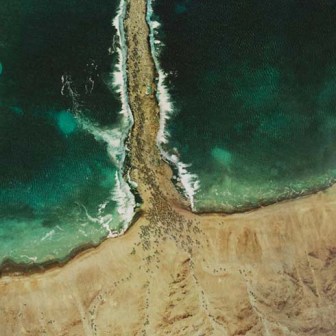
God’s Eye View of the Parting of the Red Sea
21 Then Moses stretched out his hand over the sea; and the Lord drove the sea back by a strong east wind all night, and made the sea dry land, and the waters were divided.
22 And the people of Israel went into the midst of the sea on dry ground, the waters being a wall to them on their right hand and on their left.
23 The Egyptians pursued, and went in after them into the midst of the sea, all Pharaoh’s horses, his chariots, and his horsemen.
24 And in the morning watch the Lord in the pillar of fire and of cloud looked down upon the host of the Egyptians, and discomfited the host of the Egyptians,
25 clogging their chariot wheels so that they drove heavily; and the Egyptians said, “Let us flee from before Israel; for the Lord fights for them against the Egyptians.”
The Ten Commandments – Exodus 20
1 And God spoke all these words, saying,
2 “I am the Lord your God, who brought you out of the land of Egypt, out of the house of bondage.
3 “You shall have no other gods before me.
4 “You shall not make for yourself a graven image, or any likeness of anything that is in heaven above, or that is in the earth beneath, or that is in the water under the earth;
5 you shall not bow down to them or serve them; for I the Lord your God am a jealous God, visiting the iniquity of the fathers upon the children to the third and the fourth generation of those who hate me,
6 but showing steadfast love to thousands of those who love me and keep my commandments.
7 “You shall not take the name of the Lord your God in vain; for the Lord will not hold him guiltless who takes his name in vain.
8 “Remember the sabbath day, to keep it holy.
9 Six days you shall labor, and do all your work;
10 but the seventh day is a sabbath to the Lord your God; in it you shall not do any work, you, or your son, or your daughter, your manservant, or your maidservant, or your cattle, or the sojourner who is within your gates;
11 for in six days the Lord made heaven and earth, the sea, and all that is in them, and rested the seventh day; therefore the Lord blessed the sabbath day and hallowed it.
12 “Honor your father and your mother, that your days may be long in the land which the Lord your God gives you.
13 “You shall not kill.
14 “You shall not commit adultery.
15 “You shall not steal.
16 “You shall not bear false witness against your neighbor.
17 “You shall not covet your neighbor’s house; you shall not covet your neighbor’s wife, or his manservant, or his maidservant, or his ox, or his ass, or anything that is your neighbor’s.”
The Golden Calf – Exodus 32:1-8
1 When the people saw that Moses delayed to come down from the mountain, the people gathered themselves together to Aaron, and said to him, “Up, make us gods, who shall go before us; as for this Moses, the man who brought us up out of the land of Egypt, we do not know what has become of him.”
2 And Aaron said to them, “Take off the rings of gold which are in the ears of your wives, your sons, and your daughters, and bring them to me.”
3 So all the people took off the rings of gold which were in their ears, and brought them to Aaron.
4 And he received the gold at their hand, and fashioned it with a graving tool, and made a molten calf; and they said, “These are your gods, O Israel, who brought you up out of the land of Egypt!”
5 When Aaron saw this, he built an altar before it; and Aaron made proclamation and said, “Tomorrow shall be a feast to the Lord.”
6 And they rose up early on the morrow, and offered burnt offerings and brought peace offerings; and the people sat down to eat and drink, and rose up to play.
7 And the Lord said to Moses, “Go down; for your people, whom you brought up out of the land of Egypt, have corrupted themselves;
8 they have turned aside quickly out of the way which I commanded them; they have made for themselves a molten calf, and have worshiped it and sacrificed to it, and said, ‘These are your gods, O Israel, who brought you up out of the land of Egypt!’
Moses links
Bible Heroines
Shiprah and Puah, midwives saved Moses
Bible Top Ten Plagues
Graphic photos illustrate the Ten Plagues of Egypt
Favourite Bible Movies
‘The Ten Commandments’
Movie clip of ‘The Ten Commandments‘ showing the Plagues of Egypt
The Prince of Egypt
Moses meets God
face to face
© Copyright 2006
Elizabeth Fletcher

